
Story and Photos – Rebecca Ashton
Stefan Wolff on Throughness.
As the Bereiter for Klaus Balkenhol, young Stefan got plenty of both. Klaus is a very practical straight forward sort of trainer, but he is also steeped in the German tradition and the Classical Principles. After leaving Klaus, Stefan trained in the USA where he competed FEI before returning to take the position of second in command at the prestigious Westfalien Riding School. Now back running his own competition yard, Stefan is a regular at clinics throughout the world with a well deserved reputation for really teaching not just telling the punters what they want to hear.
Let Rebecca take up the story…
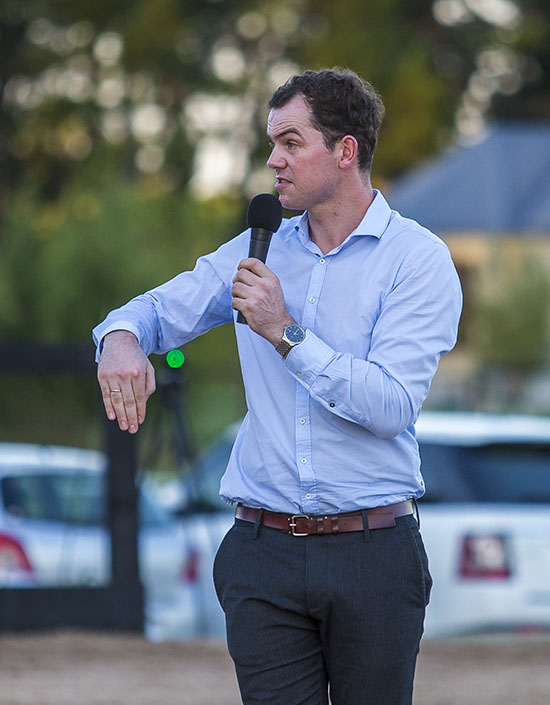
Stefan Wolff always offers a masterclass/lecture whenever he’s in Sydney. It’s a great way for the German trainer to hone in on some of his thoughts on training, making it a great supplement to his clinics, both for participants and spectators….and everyone else for that matter. There’s no ‘bells and whistles’ with Stefan’s approach, just good, correct progressions.
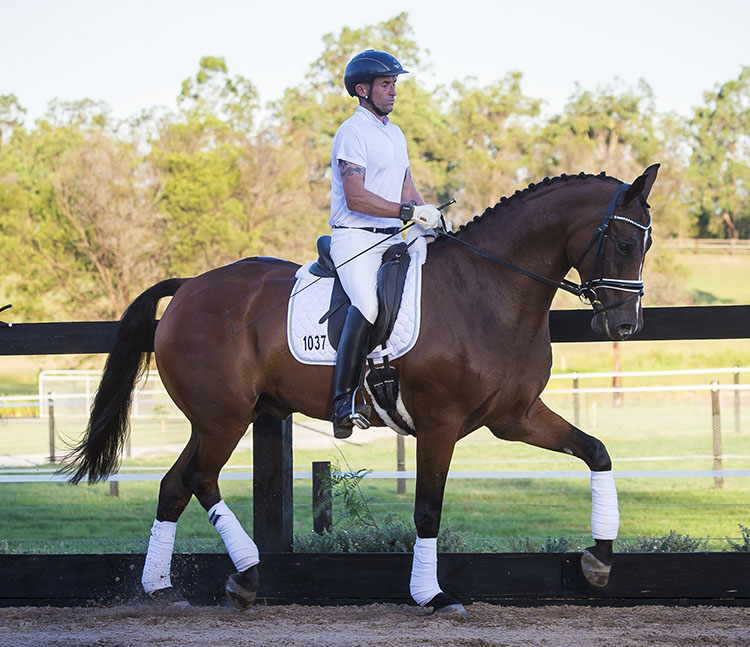
Brett and Geordie Boy
The German trainer’s aim was to clarify a few terms in riding theory. His first focus was on throughness. To help him explain was Brett Peel on Geordie Boy. Stefan began, “Rhythm, suppleness, contact, straightness, impulsion and collection should all be present at some level all the time. In training, horses usually have one or two strengths, for example, rhythm and balance, but they might tighten up. With a horse like that, we would try and find a way to get safe suppleness, and it has to be good enough to stay secure at shows.”
What did he like about the horse in front of him?
“He has a good clear rhythm in the trot. He is fairly supple. How do we decide he is supple? One of the most important points for me, is that the back moves. Right behind the saddle it needs to move. This horse has a very distinctive motion. It swings up and down. Look from behind, the croup is tilting sideways. The leg that is on the ground, that part of the lumbar is higher. From this you can see you’ve done a good job. The tail is overall fairly quiet. Consistent swishing is a sign of tension and discomfort.” Along with that came a warning against flash trots where the back doesn’t move. “You will soon get a horse with a sore back.”
story continues below the advertisement
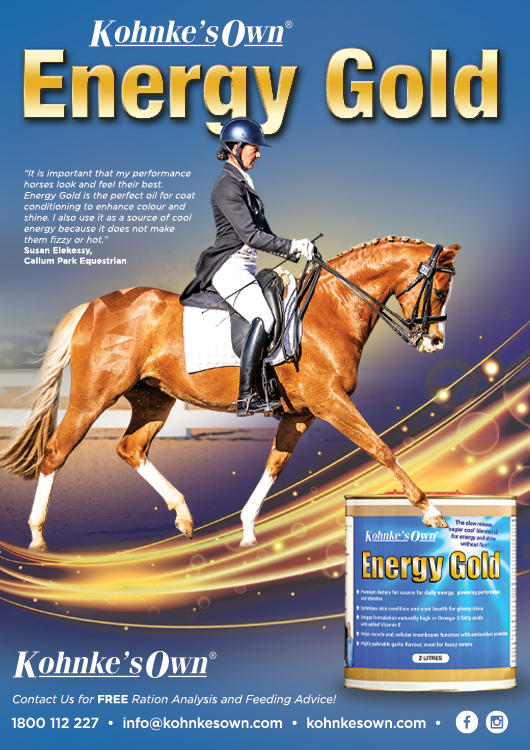
Back to Geordie Boy, “The horse has the intention to stretch. He’s not avoiding the bit. The rider can shorten the rein or lengthen it and the horse is always seeking the bit. There is room for improvement in this horse. When it stretches, there is a small hesitation. In a perfect world this wouldn’t happen.” Stefan continued, “In training, sometimes we see riding on a long rein, the horse is stretching, but there is no contact. If you look at other sports, other athletes, it’s an active stretch. There has to be a point of resistance. Athletes don’t just hang their arms down to stretch them. So, the horse must have contact with the bit.”
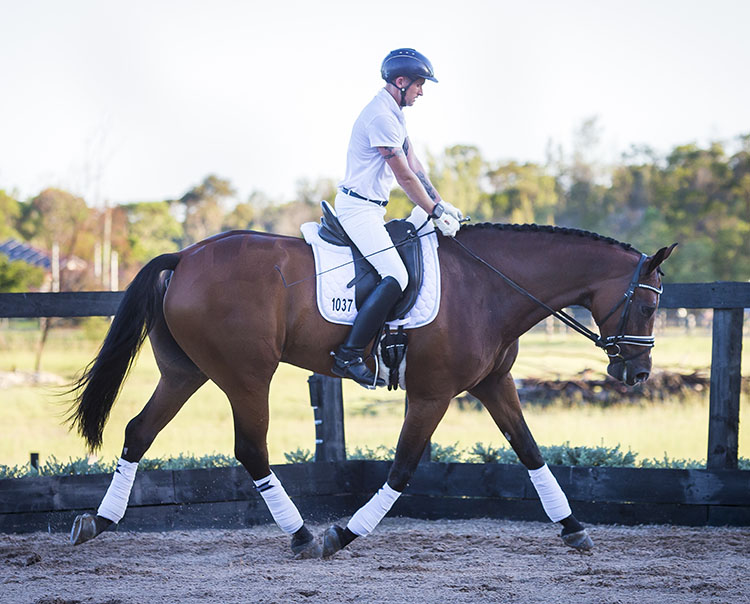
Stretching to the bit…
The pair had been working on collection over the past three days, so it was decided the theme would continue. Before they began, Stefan brought up the importance of the diagonal aid: inside leg to outside hand and refraining from riding off the inside rein. He had mentioned this numerous times to all riders throughout the clinic, and it’s an important point worth returning to frequently to keep ourselves honest.
more follows
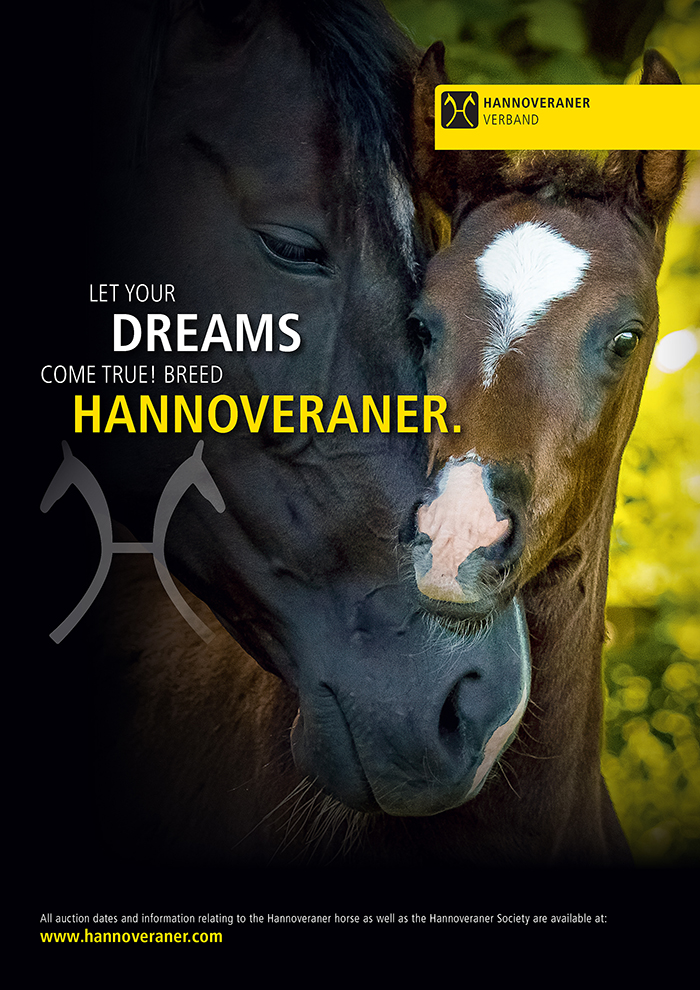
Then Brett put the young horse together a little more in sitting trot and Stefan remarked, “This is very good. He didn’t just pick up the reins, therefore the back of the horse kept working. The nice thing here is when the rein gets shorter, the horse elevates the front end, and the hind legs are swinging more under. It guarantees that when we put the horse in a shorter frame, the back stays free. We don’t lose the expression. There is confidence. The horse stretches all the way into the hand and gets a better balance.”
The half halt was then examined. Stefan instructed Brett, “Light hand. Don’t collect too much. You just want him to react to the leg and stretch to the hand,” and to the audience, “Collection does not mean to slow down. The half halt is the only way to collect the horse. The rider should not think slow, but instead more swing. The horse gets a little bit shorter, but only because the rider drives more, and that causes the horse to come from behind. This is riding from behind. I think it’s important to think about it and improve the rider’s aid, because it affects the comfort of the horse. This horse here, he doesn’t feel pressure, doesn’t feel tight. Ok, we can talk about improvement in him, but it’s five years old!”
“When you are at the peak of the half halt, the hand has to move forward. If he is pressed into the hand, the horse is tight and the rein will go loose.”
Stefan then asked for a lengthened trot to test the half halt before stretching. “Look, now the work has meant he stretches better. He’s more confident in the stretch. This has been a little bit of a weak spot in this horse, so now you see how it improves.”
Next horse was a four-year-old, read on below
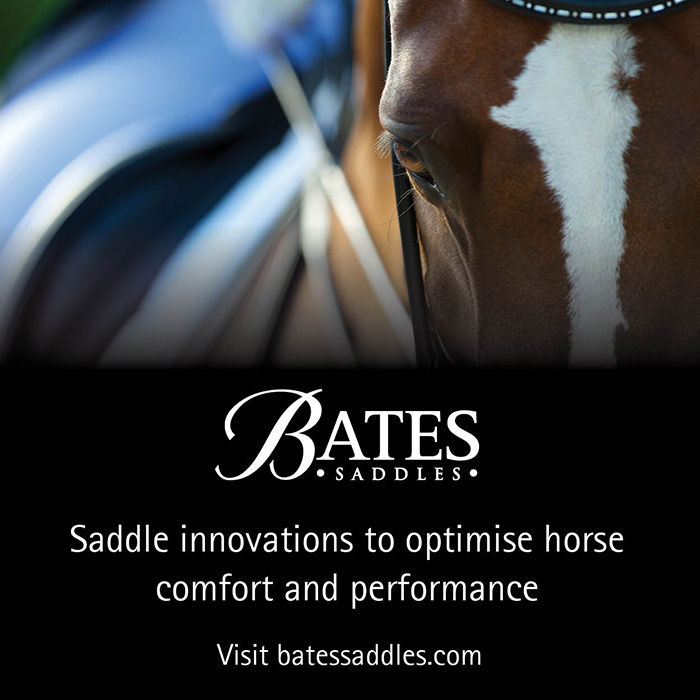
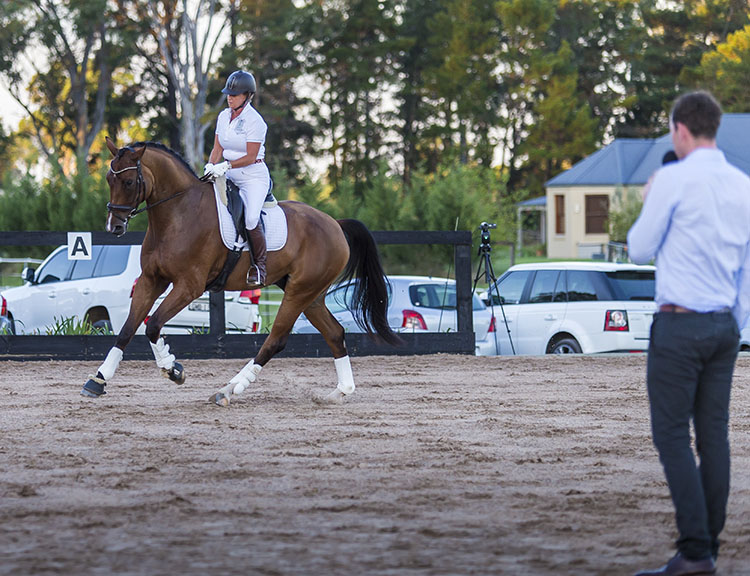
Caroline Hooper and Becks Gold
Caroline Hooper and Becks Gold II were next into the arena. Stefan wanted to get the young four-year-old relaxed, and build on his natural balance. It was more about the rider doing less.
“This is a really nicely, naturally balanced horse. What does that mean? The rider is just trotting around and you always have the impression the horse is happy in his balance, he has equal weight on all four legs, and he doesn’t need to draw the rider forward, or suck back to get his balance. His neck is always in a steady position. He knows where he is. This is very close to ideal.”
Despite this, ‘Ben’ couldn’t withhold his excitement, “The stretch is not always the same. He’s young, he’s excited but I’m not a big friend of tiring horses out. I just think there are better ways to improve the confidence of the horse. So in the next 10 minutes, I want to just lengthen his frame a bit.”
Ben gave a little hop but Stefan was totally unfazed. “Don’t worry about it. Cut him some slack. Don’t get tight. Use the flow of the movement to get the horse confident and steady. Sometimes the horse takes the inside rein, so does the rider, so now we get the rider to use the inside leg more to push the horse toward the outside rein. I’m not talking about leg yielding, that would be too much because you would get a crossing of the hind leg, and you lose some forward movement. The inside rein has got to be able to give. Here it’s not quite safe yet. If he drifts out a little and loses the perfect circle line, so what? He’s a four-year-old. Give more the inside. Be brave. When the rider gives, I want to see the poll move forward, not downward. It’s called forward and downward, because the forward has to come first. Give along the crest, make sure the horse doesn’t lose the balance. Try not to react to every little hiccup. Give him a point of reference.”
Caroline was trying to accommodate the youngster with a softer seat, but this came with a little warning, “Don’t lean forward to relieve the horse’s back. You then move everything forward. Jump riders can do it because the build of the saddle allows it. There is more room behind. You can’t do that in a dressage saddle.”
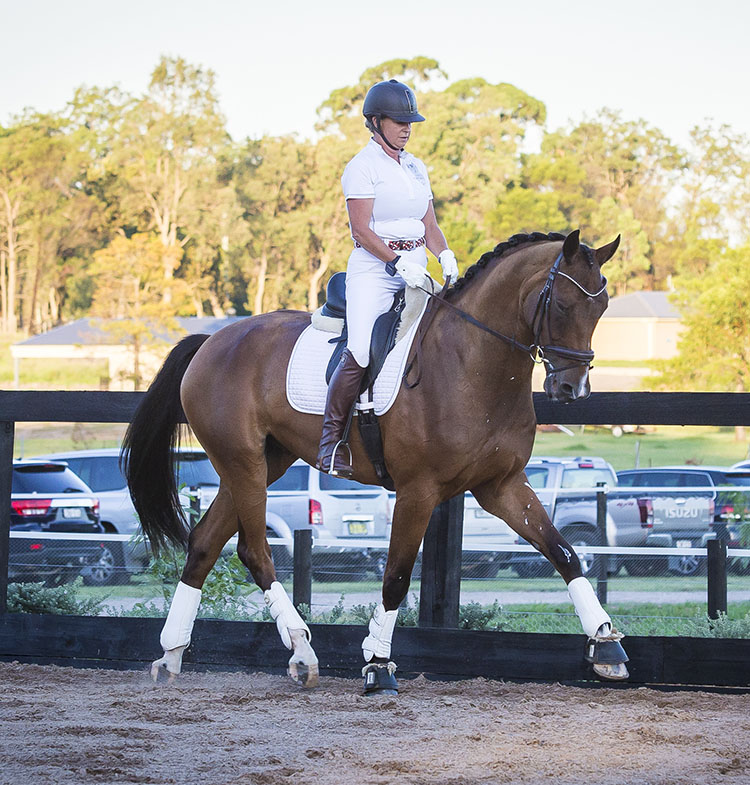 The main focus to help the horse had to be that all-important diagonal aid. “Keep the inside leg to the outside rein and the inside rein forward. You can now see the poll becomes more stable and he is quieter in the mouth. Now his tension has become less.”
The main focus to help the horse had to be that all-important diagonal aid. “Keep the inside leg to the outside rein and the inside rein forward. You can now see the poll becomes more stable and he is quieter in the mouth. Now his tension has become less.”
story continues below the advertisement
Stefan described in more detail why this was so important also in the canter. “The inside rein needs to be ahead because the inside leg is ahead of the outside in the canter. The inside hind leg jumps in front of the outside hind leg. If the inside leg pair is in front, so is the back, ear, nostril. So the rider should allow that, which is achieved by letting him jump firmer into the outside rein, not the inside. You don’t want the back to stop moving.”
The horse was then ridden forward and back in the canter with Caroline sitting back in the saddle, and giving with the rein.
Stefan knew Caroline was achieving something that can be quite a challenge, “It’s hard to be brave to give to the young horse in a strange environment. Let him go. Let him do it. Now look at the stretch at the end. Very good. Just a lovely horse.”
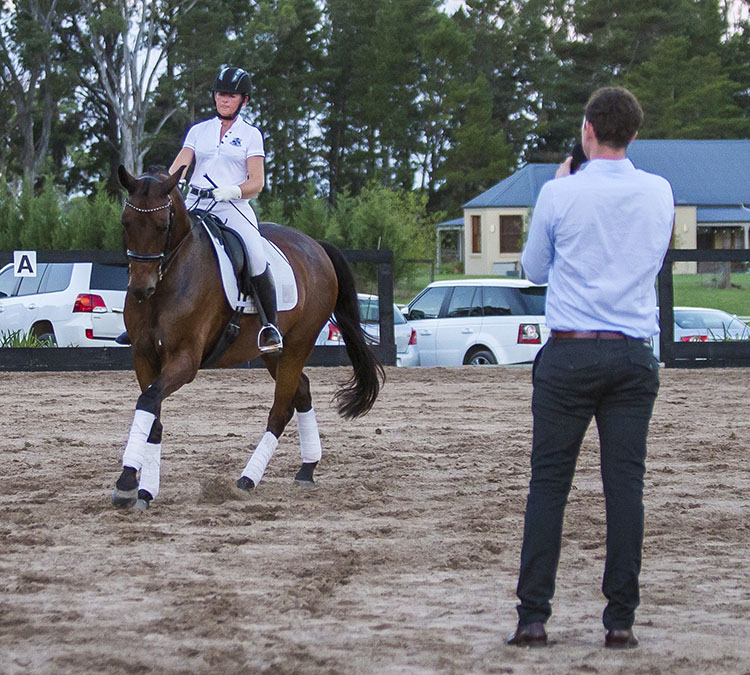
Linda and Samiro – heading for FEI
Linda Foster’s Neversfelde Samiro is heading up into the FEI ranks and Stefan commended Linda for holding the horse back in Advanced for a bit. “Sometimes we lose things as we move forward, so it’s good to go back and check things like suppleness. Linda decided to hold him back in Advanced for a while and I think it was a super decision.”
Stefan was happy with Samiro’s frame and hindleg activity, but wanted a little more suppleness through his top line. “The horse appears at first concentrated, his tail is quiet, the mouth is quiet and steady. At the same time, there is a little room for improvement in terms of a longer frame, a little bit more salivation in the mouth and jump through a little more with the hind leg. He’s in a nice collected canter, but now I want to use the half halt to improve the frame and allow the rider to give more, which will soften the back and then allow the horse more room to jump through with the hind leg.”
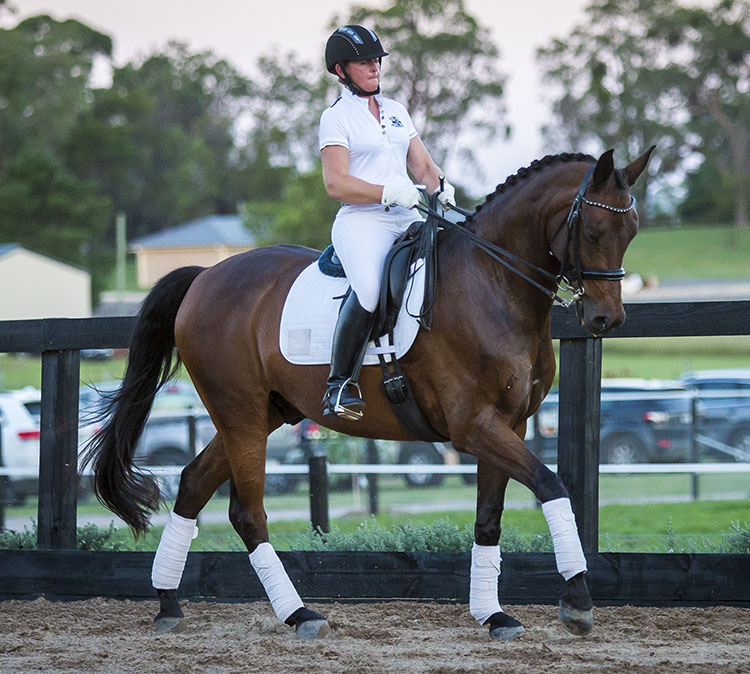
In between the collected canter moments, Linda was asked to give the horse a longer rein. “We want to see what the stretch is like. Not faster. Just see what it is. Just sit in balance. Hand forward, but try not to flick the hand. Longer and longer, until he’s on the vertical or beyond. Let him come into your hand. Sit longer and get a connection with your seat. Now just bring him back into balance. Lighter hand. There you go.”
“Don’t push with your leg aggressively, just to stimulate the horse, to get the back soft and active.
Move the back and move the poll. Right.” Stefan explained that when you look at activity, it’s not enough to just look at the hind leg, we also want the motion and swing in the back. The entire top line needs to be dynamic and flexible.
Working pirouettes were looked at and Stefan wanted them to be a little challenging for the horse to help strengthen his muscles. “Keep riding him. He will come back. Collect more, shoulder fore. Inside hand works like you want to lengthen the rein. Let him lean forward to the inside rein. Don’t hold him back. Sit back and wait, but the hand comes forward. Slower. Just keep your lower calf against him. He needs to seek the bit.”
And to the audience, “That is a process. You can see how the entire horse works and every muscle gets involved. No muscle should get shut out. Every muscle has a job and is not just waiting for the movement to be complete.”
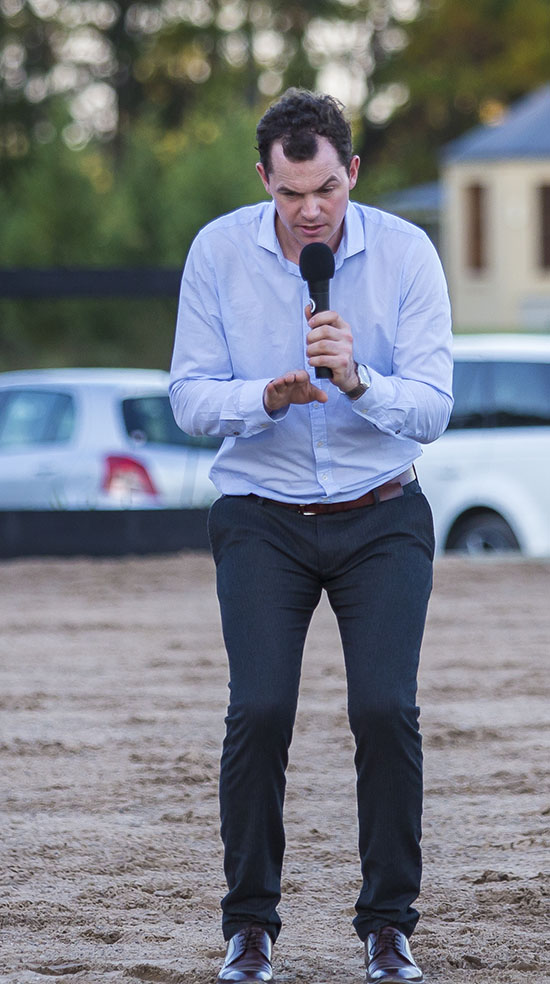
Stefan recapped the session, “You want a supple, quick reaction to the aids, not a tight, quick reaction. We aim to have the muscles working better and into better balance so you need to keep them healthy and comfortable. I think it’s nice that you can see here that both are possible. You can get the horse into a nice expressive trot and then you can stretch it. Not one or the other, both must be possible.”
“It was getting dark and Brett Peel was back with the 14-year-old Trakehner Noble Monarch has been competed to Inter 1 so knows most of the movements. Stefan wanted to touch on counter canter.
more work, in the moonlight, follows
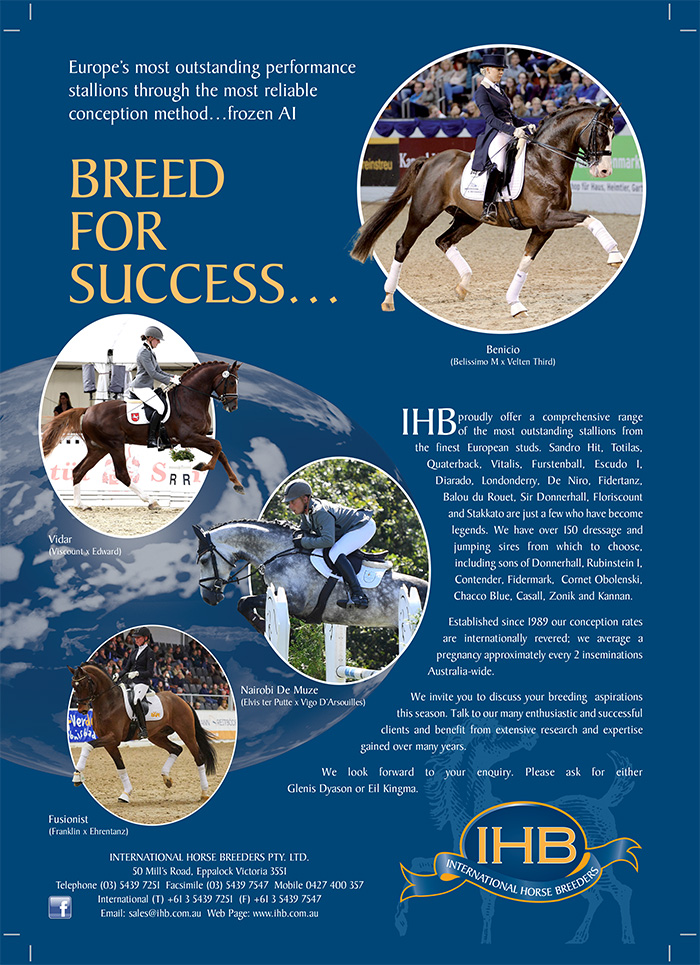
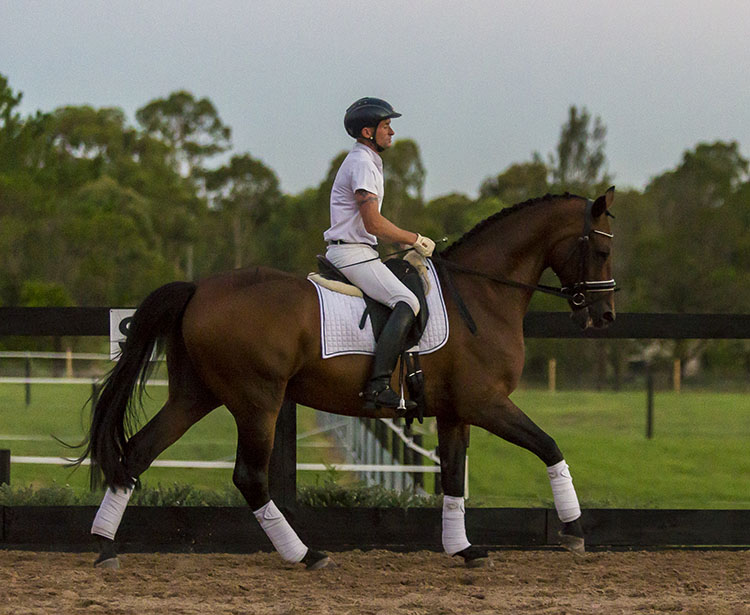
“The major reason to ride counter canter, which is not necessarily a natural thing for a horse, is to improve and check balance and straightness.” So what does a young horse usually do when first introduced to counter canter? “It comes away from the wall and drops to trot. Why? He loses his balance. The next stage, the horse will try and canter on two tracks, but we’ve made it through the corner!! So, what does a balanced and straight counter canter look like? Shoulder fore…forehand is right in front of the hind end. Naturally horses have a crookedness. The hindlegs are slightly wider than the forelegs and they are stronger on one side than the other. The hollow side is the weaker side. They move the forehand away from the hollow side. They tend to push the shoulder out to the stiff side. So, we can canter off the track to test the straightness of the canter.”
If the horse is crooked, the hind leg will be unable to step up under the horse.
Brett was then asked to show the shoulder fore. Stefan recommends this for the canter and to leave the shoulder in work for the trot as it interferes too much with the hind leg and shortens the stride. Then it was time to test out the counter canter and there was some advice as to how to ride it through the corner, “Make the turn a little more shallow. Think you are preparing a 10 metre circle into the wall. Don’t actually do it! Think it. Don’t passively sit there, hold your breath and be happy when you get through the corner without the horse trotting or changing.”
It was getting a little dark by this stage and Brett found himself riding under a full moon to finish the session with work in half pass. Stefan had some pointers, “Don’t just flex the horse to inside and take the legs across. That doesn’t say the horse is in balance. He needs to stay balanced, straight and in front of you and the back needs to keep working. To improve the balance, go straight and bring the shoulder forward and get it comfortable. Work it. Inside leg and outside rein so he comes away from the inside rein and the inside leg pair is free to move forward and the horse is forward off your seat. If you need to do a small circle, do that.”
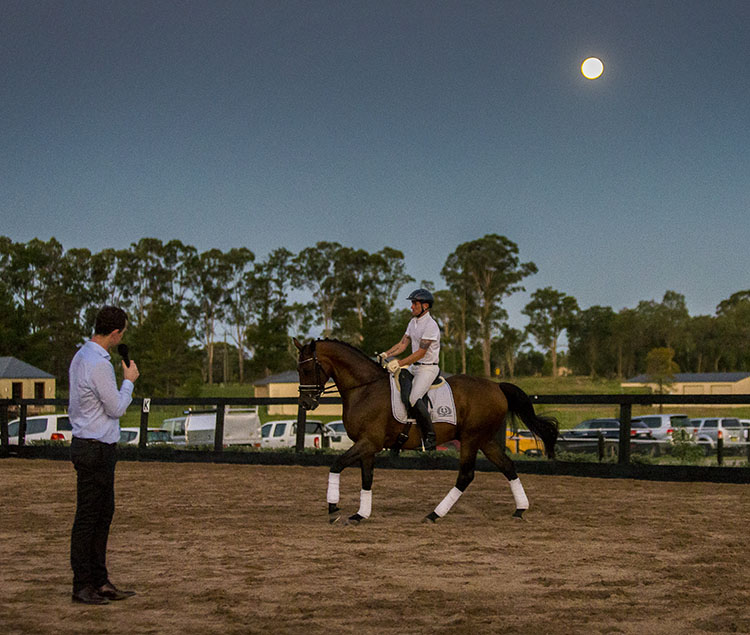
When it got a bit sticky, Stefan helped out, “Don’t move the shoulder too far forward or else you won’t get the bend in the body. Go back to shoulder fore and get the hind legs stepping forward to the bridle.” There was also a warning about trying to make the movements too difficult too soon, “Don’t just ride a steep half pass, ask yourself if you CAN ride it. Is the horse balanced enough? Around my inside leg enough?”
The message for the night really came back to one thing, “Get the basics, get the horse better, then plant the basics in the actual movements. It can take some time and patience.”
It’s worth making a special mention not only of Dianne White who organises Stefan’s clinics and lectures, but also to Stefan, and the horses and riders who helped with our understanding despite the testing climatic conditions! To Lesley Ann Taylor who hosted the clinics in her lovely indoor.
Interested in dressage? There’s a whole library of articles with the world’s leading trainers – http://www.horsemagazine.com/thm/article/dressage/
Advertise in the world’s fastest growing equestrian website – enquiries info@horsemagazine.com


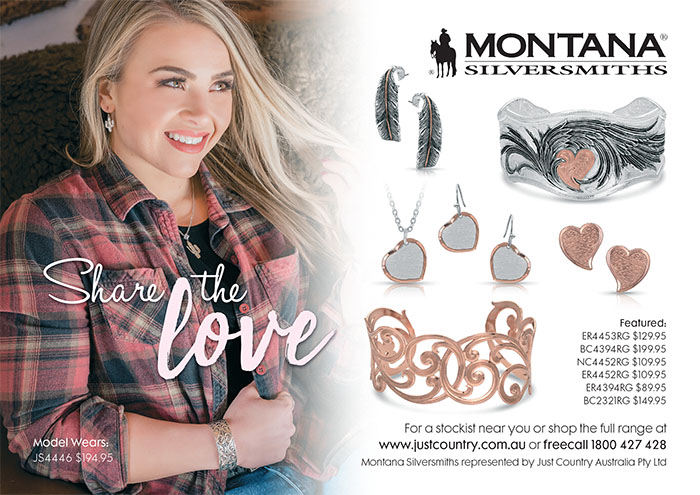
Stefan did very well as the temperature had been over 40′ for days.
It was a lovely evening and Stefan spoke very well.
He carefully managed the horses with the heat and gave the crowd good feedback.
Caroline Hooper’s horse is huge and is seriously flash.
Would be lovely to have an eventing evening with Chris Bartle yes please.
.